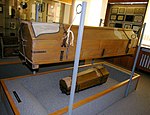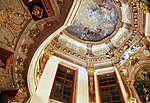Wien Hauptbahnhof
2012 establishments in AustriaBuildings and structures in FavoritenRailway stations in Austria opened in 2012Railway stations in Austria opened in 2015Railway stations in Austria opened in the 21st century ... and 1 more
Railway stations in Vienna

Wien Hauptbahnhof, Vienna Central Station or Vienna Main Station is the main railway station in Vienna, Austria, located in the Favoriten district. It became fully operational in December 2015, linking major railway lines from the north, east, south and west, and replacing the old Wien Südbahnhof terminus. With 268,000 daily commuters it is Austria's busiest long-distance railway station. Aside from being voted "Austria's most beautiful railway station" (six times in total; five years in a row), it was also second in Consumer Choice Center's ranking of "Top 10 Railway Stations for Passenger Convenience in Europe".
Excerpt from the Wikipedia article Wien Hauptbahnhof (License: CC BY-SA 3.0, Authors, Images).Wien Hauptbahnhof
Karl-Popper-Straße, Vienna KG Favoriten (Favoriten)
Geographical coordinates (GPS) Address Nearby Places Show on map
Geographical coordinates (GPS)
| Latitude | Longitude |
|---|---|
| N 48.186667 ° | E 16.38 ° |
Address
Karl-Popper-Straße
Karl-Popper-Straße
1100 Vienna, KG Favoriten (Favoriten)
Austria
Open on Google Maps











